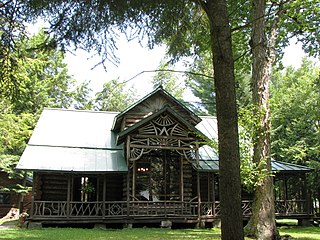
Raquette Lake is the source of the Raquette River in the Adirondack Mountains of New York State. It is near the community of Raquette Lake, New York. The lake has 99 miles (159 km) of shoreline with pines and mountains bordering the lake. It is located in the towns of Long Lake and Arietta, both in Hamilton County.

Fort Saint-Frédéric was a French fort built on Lake Champlain to secure the region against British colonization and control the lake. It was located in modern New York State across the lake from modern Vermont at the town of Crown Point, New York. The fort, whose construction began in 1734, was never attacked, and was destroyed in 1759 before the advance of a large British army under General Jeffery Amherst.
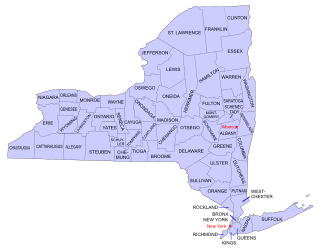
Buildings, sites, districts, and objects in New York listed on the National Register of Historic Places:

Crown Point State Historic Site is the site of a former military stronghold at the south end of the wider part of Lake Champlain. The location is in Essex County, New York, United States. The site is on a peninsula in the town of Crown Point, New York.

Camp Eagle Island, also known as Eagle Island Camp or simply EIC, was a resident summer camp located on Eagle Island in Upper Saranac Lake in New York’s Adirondack region. The camp property, including Eagle Island, two smaller islands, and a staging area on Gilpin Bay Road on the mainland, was purchased in November 6, 2015 by The Friends of Eagle Island, Inc., a 501(c)(3) tax-exempt organization whose mission has been to acquire the historic property to continue serving youth and otherwise maintain the site in the public benefit.

The Santanoni Preserve was once a private estate of approximately 13,000 acres (53 km²) in the Adirondack Mountains, and now is the property of the State of New York, at Newcomb, New York.
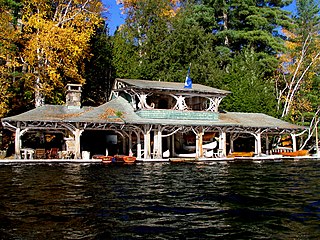
Camp Topridge is an Adirondack Great Camp bought in 1920 and substantially expanded and renovated in 1923 by Marjorie Merriweather Post, founder of General Foods and the daughter of C. W. Post. The "camp", near Keese Mill, in the U.S. state of New York, was considered by Post to be a "rustic retreat"; it consisted of 68 buildings, including a fully staffed main lodge and private guest cabins, each staffed with its own butler. It was one of the largest of the Adirondack great camps and possibly the most elaborately furnished.

Benjamin A. Muncil was an American master builder in the Adirondacks early in the 20th century. He was a major figure in the architectural development of the Adirondack Great Camps; among his many projects was Marjorie Merriweather Post's Camp Topridge, Northbrook Lodge, and White Pine Camp, a summer White House of US President Calvin Coolidge.

Camp Uncas, began in 1890, was the second Adirondack Great Camp built by William West Durant for his own use, after Camp Pine Knot, which he sold to industrialist Collis P. Huntington, due to financial difficulties. It was built on the shore of 110-acre (45 ha) Lake Mohegan, near Sagamore Camp. Uncas was completed in two years.

Knollwood Club is an Adirondack Great Camp on Shingle Bay, Lower Saranac Lake, near the village of Saranac Lake, New York, USA. It was built in 1899–1900 by William L. Coulter, who had previously created a major addition to Alfred G. Vanderbilt's Sagamore Camp. The "club" consisted of a boathouse, "casino", and six identical 2 1⁄2-story shingle cottages, which were distinguished by unique twig work facades.

Begun in 1882, Camp Wild Air was the first permanent camp on Upper Saint Regis Lake, in the town of Brighton, Franklin County in New York's Adirondacks. The camp was built by New York Herald Tribune publisher Whitelaw Reid on a 29-acre (12 ha) peninsula accessible only by water. It presently consists of 12 buildings, 10 of which were built before 1931.
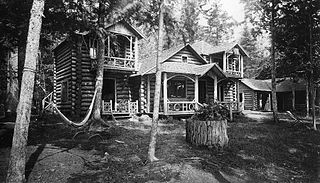
Echo Camp is an Adirondack Great Camp on the tip of Long Point adjacent to Camp Pine Knot on Raquette Lake. It was used as a private girls' camp from the mid-1940s to the mid-1980s. It was sold in 1986, and is now a privately owned summer residence.
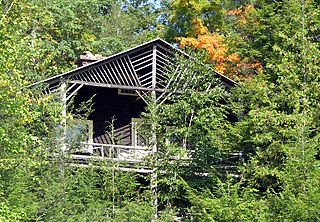
Moss Ledge is an Adirondack Great Camp designed by William L. Coulter in 1898 for Isabel Ballantine of New York City. Ballantine was the daughter of Newark beer baron, John Holmes Ballantine.

Prospect Point Camp is an Adirondack Great Camp notable for its unusual chalets inspired by hunting lodges. William L. Coulter's design is a significant example of the Adirondack Rustic style. It is located on a bluff overlooking the northern reaches of Upper Saranac Lake, near Eagle Island Camp and Moss Ledge, two other Coulter designs. Its grand scale is typical of the opulent camps of the area in the great camp era. The camp was built for New York copper magnate and financier Adolph Lewisohn.

Pine Tree Point was the Adirondack Great Camp on Upper St. Regis Lake of Frederick William Vanderbilt, a director of the New York Central Railroad for 61 years. Vanderbilt maintained residences in New York City at 450 Fifth Avenue, Hyde Park, Newport, and Bar Harbor ("Sonogee").

The Hedges is a historic home and Adirondack Great Camp located at Blue Mountain Lake in Hamilton County, New York. The property consists of 30 buildings and structures and many related site features. From about 1890 to 1920, it was the seasonal home of Hiram B. Duryea, and from this period nine buildings and structures remain. In 1920, it was purchased by Richard J. Collins and converted to an Adirondack resort. The Main Lodge complex was built in 1882; the main block is a two-story, wood-framed building with a mansard roof. The Stone Lodge was built 1900–03 and is a two-story gambrel-roofed building.

Lacawac is a historic estate located in Paupack Township and Salem Township, Wayne County, Pennsylvania. It was built in 1903, as a summer estate of Congressman William Connell (1827-1909). Six of the eight buildings remain. They are the main house, barn, spring house, pump house, Coachman's Cabin, and ice house. The buildings are in a Adirondack Great Camp style. The main house is a 2 1⁄2-story frame dwelling with a cross gable roof. It features two-story porches and the interior is paneled in southern yellow pine.





